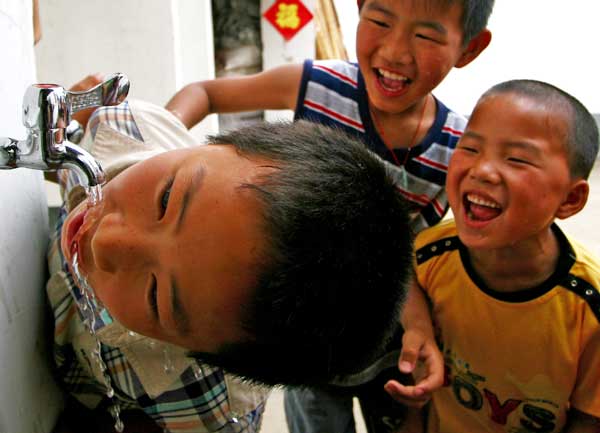Foreign and Military Affairs
More actions needed to sustain MDG progress
(China Daily)
Updated: 2010-09-22 12:06
 |
Large Medium Small |
 |
|
Children drinking clean water from a newly-installed water tap. Yu Ji / for China Daily |
According to the UN, although the poverty rate in East Asia has decreased from 60 percent to 16 percent, it stayed above 50 percent in sub-Saharan Africa despite improvements in primary education enrollment.
"China has shown an impressive number in poverty reduction. How did they do it - that is something that can be learned by African and LDC countries," he said, adding that the increasing population is one factor that affects African countries' economic growth.
Among the eight goals, Goal 5 is focused on improving maternal health, which aims to reduce the maternal mortality ratio by three quarters between 1990 and 2015. Although there has been some progress, the Report shows that the rate of reduction is still well short of the 5.5 percent annual decline needed to meet the Goal.
"Here we need strong political will from leaders from the concerned countries. Also, strong support needs to be given to the international community," Diarra said.
Diarra believes that official development assistance (ODA) can contribute a lot to Africa and LDCs in the MDGs. But with most donor countries (including European countries and OECD countries) now facing new realities such as the financial crisis, the ODA has been declining.
At the Gleneagles Summit in 2005, G8 leaders promised to increase aid to developing countries by about $50 billion by 2010. Nearly $25 billion of the amount will go to Africa.
However, the MDG Report pointed out the shortfall in aid, which affects Africa in particular. It is estimated that Africa will receive only about $11 billion out of the $25 billion increase, due mainly to the under-performance of some European donors.
While recognizing ODA will still be much needed by Africa and LDCs at least in the short term, Diarra suggested to "head toward foreign direct investment" to create employment in these countries. This will also help improve employment among youth, which he sees as another challenge ahead for many countries.
"There are things that can be done without costing a dime to the donor countries and which will be of help to the LDCs and Africa. For example, creating incentives for the private sector to come to invest in these countries (linked to the attainment to the MDGs)," he said, adding that the creation of the China-Africa Development Fund in 2007 was a good example of this.
In 2007, China launched the China-Africa development fund to the value of $1 billion to encourage, finance and support Chinese companies in their investments across the African continent.
In a time of different crises the world is facing, including climate change, food security, and economic downturn, it has made it more challenging to achieve all these goals.
"All these crises are intertwined, and they all have negative impacts," he said.
"But I hope to see world leaders to reaffirm the political will, to learn from the successes and failures of their peers, and from there, to give a final push at the national level to achieve the goals," Diarra said, adding that it is key for the world leaders to "deliver on the promise" in the next five years.











